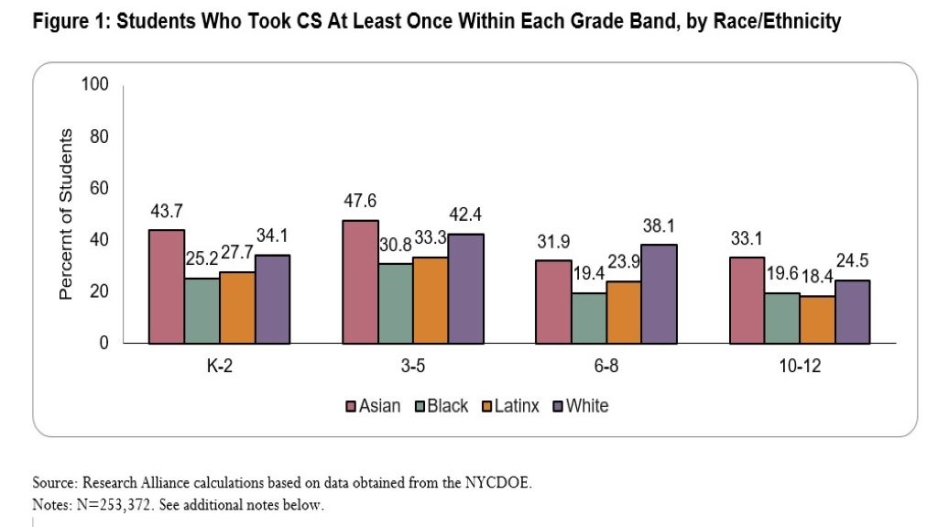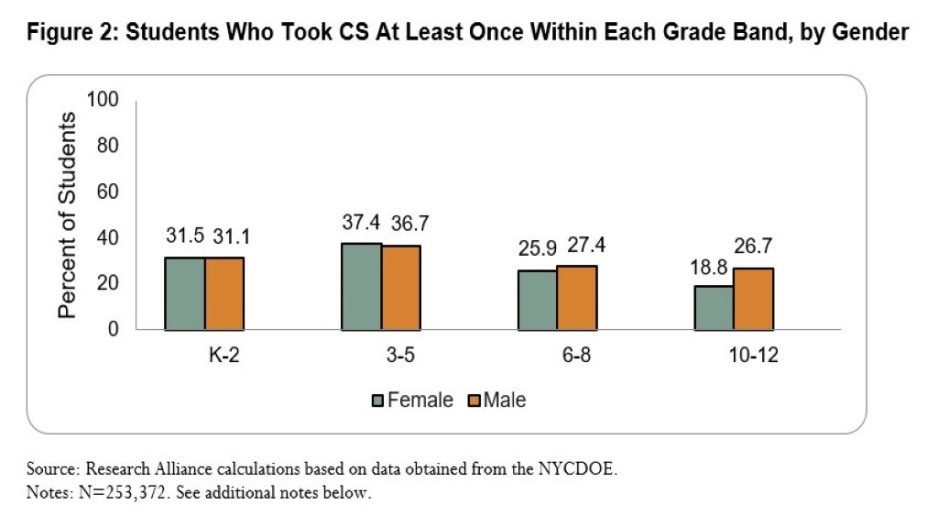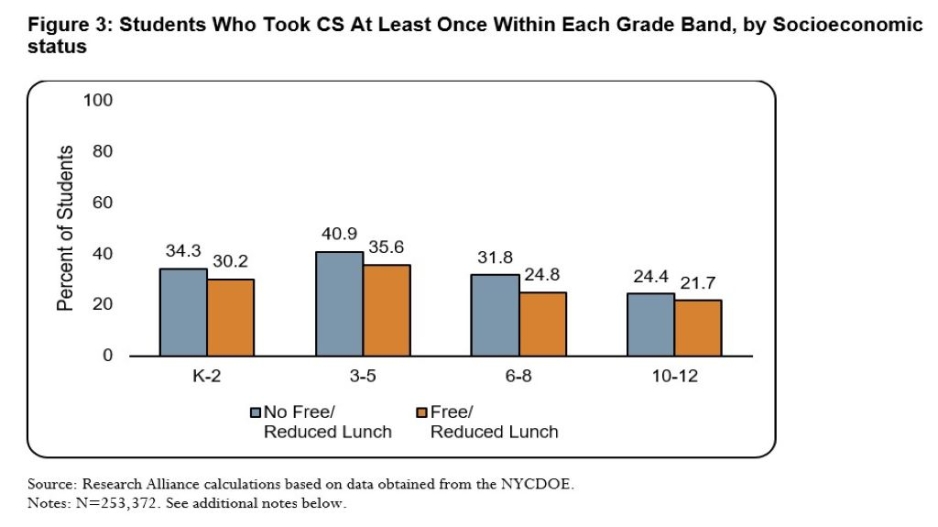In recent years, policymakers, educators, and researchers have come to see computer science (CS) education as crucial to prepare students for the demands of the future workforce. There is also evidence that CS can support the development of other valuable skills (e.g., problem solving, persistence, creativity); that it promotes innovation; and that it is important for advancing social justice goals. For all of these reasons, a growing number of schools and districts across the country are implementing CS initiatives and policies. Many of these focus on promoting equitable participation, to address well-documented gaps in access to CS education and to STEM (science, technology, engineering and math) more broadly.
New York City’s Computer Science for All (CS4All) Initiative
One of the most extensive and high-profile CS education initiatives is New York City’s CS4All. Started in 2016, CS4All’s overall goal is to ensure that all public school students—especially female, Black, and Latinx students (who historically have been underrepresented)—learn computer science. Specifically, the initiative aims to provide at least one meaningful and high-quality CS experience at each grade band: Kindergarten to second grade, third through fifth grade, sixth through eighth grade, and ninth through twelfth grade.
As part of the Research Alliance’s evaluation of the CS4All initiative, we have been examining progress toward equitable CS participation in NYC schools. To date the initiative has reached an impressive number of teachers and students. By 2020, more than 2000 teachers from over 900 NYC schools had participated in CS4All professional development, and there have been year-by-year increases in the number of students taking CS, including a steady rise in Black, Latinx, and female student participation. We’ve also seen an increasing number of CS AP test-takers, particularly among young women. Indeed, between 2016 and 2018, the percent of AP test takers has increased by 55 percent for Black and 46 percent for Latinx students and by over 400 percent for female students.
Although these changes are encouraging and demonstrate the progress of the CS4All initiative, there is more work to be done to overcome longstanding disparities. This Spotlight post uses data from the 2016-2017 through 2018-2019 school years to explore NYC students’ participation in CS across grade bands. We focus here on differences associated with race and ethnicity, gender, and socioeconomic status. Future posts in this series will examine other differences, such as those associated with disability, English language learner status, and students’ prior achievement. Our analysis encompasses different kinds of CS instruction, including dedicated CS courses as well as CS units that have been integrated into other courses (math, science, etc.). CS4All initiative leaders are using the findings below, and others from the Research Alliance’s evaluation, as they continue working to expand access to CS in NYC schools.
Key Findings
1. There are racial disparities in CS participation across all grade bands.
2. Small differences between boys' and girls' participation in CS start in middle school and grow during high school.
3. Students who were eligible for free and reduced-price lunch participate in CS at a slightly lower rate across grade bands.
Race/Ethnicity
Overall, NYC’s Asian and White students participated in CS instruction at a higher rate than Black and Latinx students during this period. As shown in Figure 1, these disparities were present in all grade bands. Asian students generally had the highest rates of participation. While White students participated in CS less than Asian students (with the exception of middle school), both groups consistently had higher levels of participation than Black and Latinx students. Our findings are aligned with previous STEM and CS education studies that have found racial disproportionality in CS participation and highlight continued room for improvement in New York City, in spite of the increase in Black and Latinx students’ participation since the CS4All initiative began.

Gender
Gender disparities in CS participation were less evident. Overall, we found that boys participated at a slightly higher rate (30.7%) than girls (28.6%). However, Figure 2 highlights that these disparities were not present in all grade bands. In fact, girls’ participation in CS was actually somewhat higher than that of boys in elementary school. This pattern was reversed in middle school and became more pronounced in high school—at which point, boys were about 8 percentage points more likely to take CS. These findings support previous STEM research, which has found that gender differences in STEM participation develop in later grades.

Socioeconomic Status
Overall, we found modest differences (about 4 percentage points) between the participation rates of students who were eligible for free or reduced-price lunch (FRPL) and those who were not. As shown in Figure 3, these differences persisted across all four grade bands, ranging from approximately 3 to 7 percentage points. Interestingly, in contrast to our gender findings, the smallest difference in CS participation by FRPL status were at the high school level.

What Might Explain These Differences in Participation?
Our results raise important questions about access and opportunity—namely who is being offered CS, and is a lack of access lowering CS participation rates for some students? Our previous work on the landscape of CS in NYC found, for example, that schools serving primarily Black and Latinx and lower socioeconomic status students were less likely to provide CS opportunities. One reason for this may be related to the fact that these schools are also more likely to be low performing, and therefore, may prioritize raising test scores and graduation rates over CS instruction.
How CS is being implemented also matters for student access and participation. In NYC, there are two approaches to CS instruction: stand-alone CS course, and courses in which CS is integrated into other subject areas. Often, these are core subjects that all students take, which automatically improves access. Integrated CS is more common during elementary school, which may help explain why boys and girls take CS at similar rates in earlier grades. In high school, CS courses are primarily stand-alone. Some of these courses require prerequisites, which can be a barrier to participation. Furthermore, during high school, as students contend with required coursework necessary for graduation, they may be less likely to opt into elective CS courses.
This highlights the complicated role that choice plays in CS participation. Students who are confident and believe they can succeed in STEM and/or CS are more likely to engage in these areas. Therefore students’ own CS attitudes and beliefs could explain some of the racial and gender disparities in student participation, especially at the middle and high school level. These are vital periods when students develop their identity and sense of self; during this time, Black, Latinx, and female students may internalize contextual cues (e.g., images that perpetuate stereotypes and lack representation) implying CS is not for them, leading them to ‘opt out’ of CS courses. Teachers, parents, and guidance counselors also provide input and direction as students select coursework and navigate their school to career pathways. These adults may (positively or negatively) influence students’ CS attitudes and beliefs as well as their engagement and participation in CS.
The CS4All initiative is working to address these issues in a variety of ways, including providing teacher and school leader professional development on equity-based strategies and practices, building Culturally Responsive – Sustaining Education (CR-SE) into CS4All’s core programming; and hosting CS events for teachers, students, and the larger CS community. Looking ahead, the Research Alliance will continue examining and informing the initiative’s efforts to create a sustainable and inclusive CS culture in NYC schools.
Big Questions
These results raise critical questions about disproportionality and participation in CS education, which we will continue to examine in partnership with initiative leaders:
- What are the factors that lead to disproportionality in CS course taking? What school policies and instructional practices promote equitable participation in CS education?
- To what extent is equitable CS participation influenced by school resources and/or characteristics (e.g., technology support, internet access, availability of teachers qualified to teach CS)?
- To what extent is equitable CS participation influenced by student attitudes toward CS?
- What is the relationship between course type (i.e., stand-alone vs. integrated; foundational vs. more advanced) and CS participation, especially for students from underrepresented groups? Do participation rates vary by the type of CS instruction?
- How do these findings connect to the much larger and pervasive structural and systemic factors that disproportionally and negatively impact low-income students and students of color (e.g., generational wealth gap, incarceration rates, suspension and expulsion rates)?
What else should we be asking about computer science education in NYC schools? Let us know via email.
This post was authored by Alexandra Adair, with analytic support by Ethan Crasto and editing by Cheri Fancsali and Chelsea Farley. This post is based on research conducted for our ongoing study of the NYC CS4All initiative, in which the Research Alliance is answering important questions about the implementation and impact of the initiative for NYC students, schools, and teachers. The study is supported by the Fund for Public Schools.
Additional Table Notes:
Data for these analyses are from the NYCDOE Student Tracking and Registration System (STARS). The sample includes students in Districts 1-32 who had the opportunity to take at least one CS course in a three-year period, corresponding to the CS4All grade-band goals. Specifically, it includes students who were in grades 2, 5, 8, and 12 in the 2018-2019 school year. We identified CS participants as students in this sample who took any type of CS course in 2016-2017 through 2018-2019.
How to Cite this Spotlight
Adair, A. 2021. "Who is Taking Computer Science in New York City Schools?" Spotlight on NYC Schools. Research Alliance for New York City Schools.

